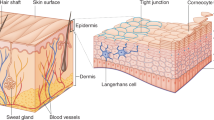Abstract
Cosmetics are products that are designed to maintain or improve visual appearance when applied to skin. Skin is a mechanically flexible substrate that changes in chemical and surface properties during the course of the day. Sebum (an oily substance secreted by the sebaceous glands) and perspiration (a secretion of mostly salt water by the eccrine glands) as well as environmental insults work counter to the desired benefits of cosmetics on physical appearance. Recent advances in the ability to control morphology and chemical properties have led to novel materials that in turn have enabled the development of cosmetics that provide, on the one hand, a more natural look, and on the other, unique and unprecedented visual effects. Progress in understanding skin biomechanics and surface properties lead to product formulations with unprecedented wear and performance characteristics. This article reviews recent advances in the ability to control the optical, bulk, and surface properties of materials, and their application to improved cosmetic formulations.
Similar content being viewed by others
References
M.C. Schlossman, Ed., The Chemistry and Manufacture of Cosmetics, Volume II: Formulating (Allured, Carol Stream, Ill., 2000) pp. 629, 707.
V. Ferrari, “Cosmetic composition containing a polymer and a fluoro oil,” U.S. Patent 7,052,681 (May 30, 2006).
W.F. Larrabee, Laryngoscope 96, 399 (1986).
F.R. Morgan, J. Soc. Leather Trades Chem. 44, 171 (1960).
R.W Carton, J. Dainauskas, J.W. Clark, J. Appl. Physiol. 17, 547 (May 1962).
C.H. Daly, in Proc. 8th Int. Conf. Med. Biol. Eng. (1969) p. 18.
J.C. Dick, J. Physiol. 112, 102 (1951).
M.L.R. Harkness, R.D. Harkness, Nature 183, 1821 (1959).
J.C. Barbenel, J.H. Evans, J. Invest. Dermatol. 69, 318 (1977).
J.B. Finlay, J. Biomech. 3, 557 (1970).
E. Berardesca, Dermatologica 182, 89 (1991).
L. Rodrigues, Skin Pharmacol. Appl. Skin Physiol. 14, 52 (2001).
S. Diridollou, Skin Res. Technol. 6, 214 (2000).
J. Delarie, in Muscle Adaptation in the Craniofacial Region, D.S. Carlson, J.A. McNamara, Eds. (University of Michigan Press, Ann Arbor, 1978) pp. 157–180.
M.L. Fogel, Br. J. Plast. Surg. 37, 542 (1984).
J.L. Leveque, Dermatology 208, 307 (2004).
S. Weinstein, Isr. J. Dent. Sci. 2, 51 (1988).
T.P. Ho, J. Biomech. 115, 859 (1982).
A.C. Park, J. Cosmet. Chem. 23, 3 (1972).
B.F.V. Duzee, J. Invest. Dermatol. 71, 140 (1978).
J.D. Rigal, Bioeng. Skin 1, 13–23 (1985).
R. Rudavsky, “Mechanical Properties of Human Stratum Corneum: Influence of pH Treatment,” in 2004 NNIN REU Research Accomplishments (Columbia University, New York, 2004) p. 106.
W.A. Zisman, “Contact Angle, Wettability, and Adhesion,” in Advances in Chemistry, Series 43 (American Chemical Society, Washington, D.C., 1964) p. 1.
J.C. Charkoudian, J. Soc. Cosmet. Chem. 39, 225 (1988).
A. Elkhyat, P. Agache, H. Zahouani, P.H. Humbert, Int. J. Cosmet. Sci. 23, 347 (2001).
C. Pailler-Mattei, H. Zahouani, Tribiol. Int. 39, 12 (2006).
M. Takahashi, SÖFW-J. 126, 6 (2000).
N. Magnenat-Thalmann, P. Kalra, J.L. Lévêque, R. Bazin, D. Batisse, B. Querleux, IEEE Trans. Inf. Technol. Bioeng. 6, 317 (2002).
S.M. Anasiewicz, Tappi J., 159 (October 1988).
C.S. Gun, Encyclopedia of Polymer Science and Engineering (Wiley, New York, 2003, ed. 3) pp. 97–138.
A. Eisenberg, Physical Properties of Polymers (American Chemical Society, Washington, D.C., 1993, ed. 2) p. 61.
M.M. Feldstein, Polym. Sci. Ser. A 46, 1165 (2004).
B. Arkles, MRS Bull. 26 (5), 402 (May 2001).
L. Sobieski, T.J. Tangney, in Handbook of Pressure Sensitive Adhesive Technology, D. Satas, Ed. (Van Nostrand Rheinhold, New York, 1989, ed. 2) p. 508.
L.E. Dreschsler, T.E. Rabe, E.D. Smith III, “Transfer-resistant cosmetic preparations,” U.S. Patent 6,074,654 (March 26, 1999).
R.G. Schmidt, L.R. Badour, G.V. Gordon, Synthesis and Properties of Silicones and Silicone-Modified Materials: ACS Symp. Ser. 838 (American Chemical Society, Washington, D.C., 2003) p. 170.
S. Yukari, N. Kazuhiro, N. Naoki, J. SCCJ 36, 25 (2002).
E.B. Faulkner, W.J. Zavadoski, Cosmet. Toiletries 109, 69 (1994).
T. Miyoshi, Personal Care 2 (4), 51 (2001).
J. Shiozawa, J. Soc. Cosmet. Chem. Jpn. 27, 326 (1993).
L. Rigano, P. Muukkonen, SÖFW-J. 129 (36), 38 (2003).
A. Braunagel, SÖFW-J. 128, 48 (2002).
A. Hunter, Cosmet. Toiletries 119, 51 (2004).
L.E. Drechsler, T.E. Rabe, E. Smith III, “Transfer-resistant cosmetic compositions,” U.S. Patent 6,139,823 (October 31, 2000).
L. Rigano, P. Muukkonen, SÖFW-J. 129 (36), 38 (2003).
Rights and permissions
About this article
Cite this article
Maitra, P., Brahms, J. Challenges in Cosmetic Formulations: Appearance, Long Wear, and Comfort. MRS Bulletin 32, 787–792 (2007). https://doi.org/10.1557/mrs2007.165
Published:
Issue Date:
DOI: https://doi.org/10.1557/mrs2007.165




